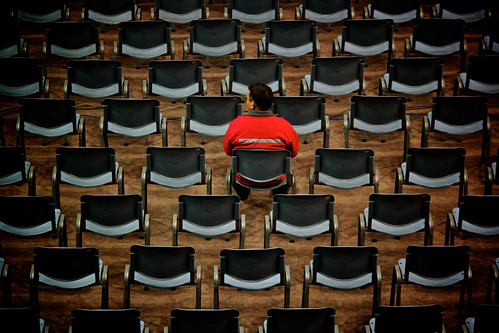Social Isolation In The Midst Of A Crowded General Session
Rows and rows of chairs in straight lines face the stage.
Aisles separate sections of chairs so people can navigate the room.
The large ballroom easily seats 5,000 people theater style. The air is cold and stale. The lights dim. A dancing image appears on the front screens and the delay screens hanging from the ceiling.
Why this setup? Why this method? What’s the goal of this ballroom-style general session?
Efficiency Not Effectiveness
As some iconic image from Apple’s 1984 Mac commercial, people walk in orderly fashion, fill in the chairs and stare intently at the screens during general sessions.
The goal of this general session is an efficient way to control a message from the front of the room. It’s all about a one-to-many monologue. Ultimately, the goal is to persuade the audience to do something…think, act or behave in a specific way. Yet, it is not the most effective.
In short, we are treating our attendees like robots trying to download data from the speaker into their hard drives, the brain. We think that if our attendees hear the information, they automatically learn it.
Unfortunately, listening to information does not translate into learning it. Of course the exception to the rule is the rare few like Marilu Henner who have superior autobiographical memory, the ability to recall specific events from the past. (Less than 300 people have this ability.)
We assume that if everyone hears the same thing the same way at the same time, they will respond the same. That assumption is false at best.
Social Isolation Hampers Learning
When we require our attendees to sit passively and quietly in rows with little or no social interaction, we work against the brain’s natural social systems.
We rob attendees of the chance to engage, interact and learn.
We create social isolation in the midst of a crowd.
Even more discouraging is that feeling of aloneness can have a crippling affect on learning. We want to know if what we are thinking and feeling is similar to what others are thinking and feeling. But we can’t do that when we are not given the chance to converse.
Our conferences need a balance of group social learning and individual experiences. Currently, the majority of the conference experience favors individual experience and social isolation within the crowd. We need to change that.
Social Events Influence Cognitive Functions
Humans are social beings. We have social brains.
The areas of our brain active in processing social events (emotional pathways, frontal lobes, sensory cortex and visual system) also process our cognitive thinking. Their double duty explains why social events so strongly influence or cognitive processing.
There is ample evidence that face-to-face peer interactions can enhance learning. The idea that “we are all in this together and can help each other” actually aids learning. When we know that our problems are common, we feel a sense of relief instead of threat.
Ultimately, cooperatively working together in small groups during a conference enhances cognitive processing.
What are some ways to reduce social isolation in the conference crowd? What are some common ways to create cooperative, small group, peer sharing experiences during conferences?



“What are some common ways to create cooperative, small group, peer sharing experiences during conferences?”
Sadly, I wouldn’t say the use of ways to create cooperative, small group, peer sharing experiences is common during conferences.
The Three Questions, pair work, human spectrograms (aka body voting or human graph), affinity grouping, plus/delta, personal introspectives, case studies, and fishbowls are the techniques I most commonly use.
My book about about these techniques, including why and when to use them should be out next year.
‘@Adrian
Thanks for reading and commenting. I think one of the easiest ways to create peer sharing is discussion. Speakers can ask audience members to turn to their right or left and talk to the person closest to them.
[…] Social Isolation In The Midst Of A Crowded General Session […]
[…] Social Isolation In The Midst Of A Crowded General Session When we require our attendees to sit passively and quietly in rows with little or no social interaction, we work against the brain's natural social systems. Source: velvetchainsaw.com […]
And (again) sadly, Jeff, that’s about all you can do with a thousand people in theatre seating. (Unless you’re Jean Houston…)